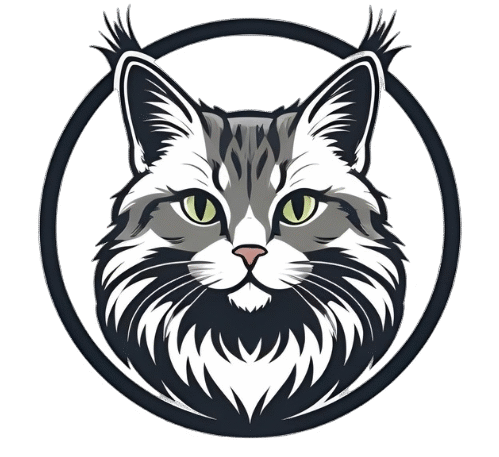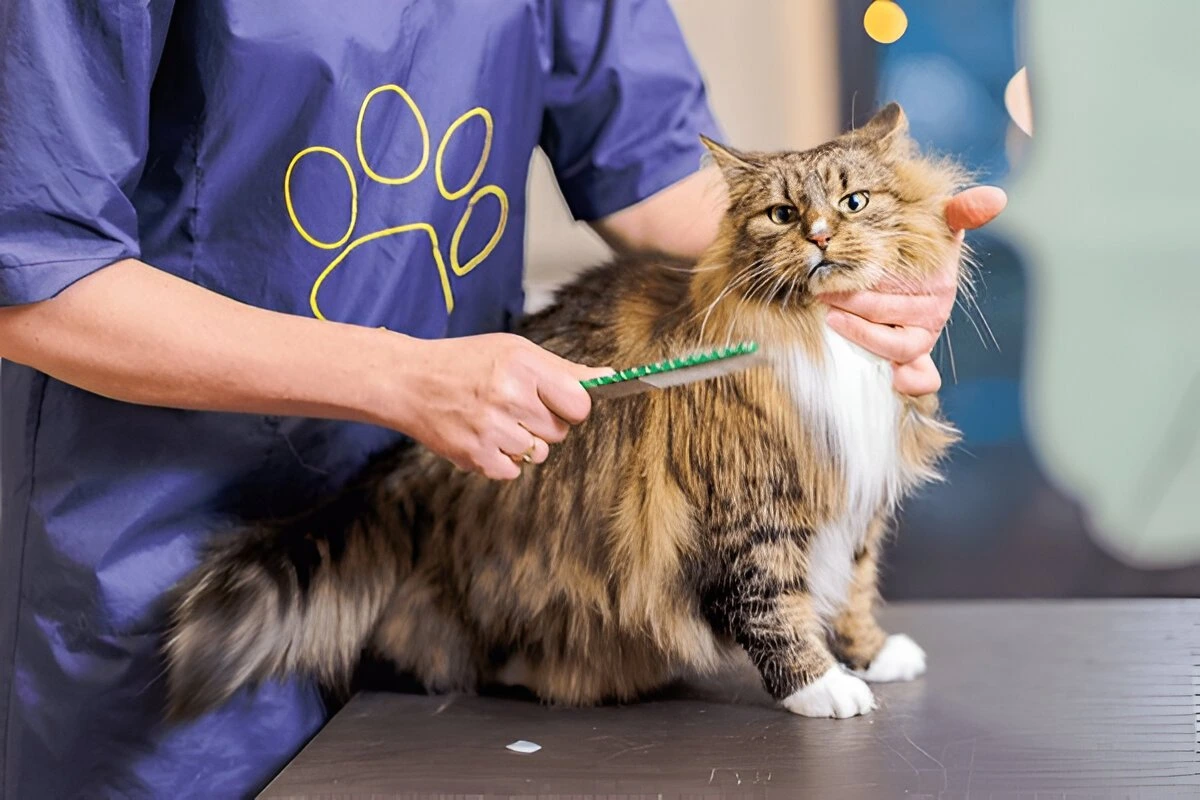If you’ve ever wondered why Maine Coons shed, you are not alone. These big, fluffy cats are renowned for their long, beautiful fur, as well as the “fur tumbleweeds” that appear overnight in your house.
When Max first came into our home, I was surprised at the amount of fur he had. His coat was lion-like, and his tail was bushy enough that it could sweep the floor!
But is shedding really as bad as some people make it out to be?
Or is it another myth associated with this great breed?
Let’s bust some myths, learn some truths, and see how best to maintain both your home and your Maine Coon—while appreciating why Maine Coons are worth so much money in the first place.
Why Does My Maine Coon Shed So Much?
If you find yourself sweeping up fur daily, you may be thinking that something is wrong. All cats shed, but Maine Coons have a double coat; they have a fluffy, thick undercoat and longer, lustrous guard hairs layered on top.
The coat is designed to help keep the cat warm in cold weather and cool in the heat. Because of this, Maine Coons shed, especially during seasonal change.
In spring and fall, my Coon Max seems to drag debris everywhere he goes, like little tumbleweeds of fur. This is very normal, he is simply shedding his winter coat and growing out a lighter summer coat..
A big reason why Maine Coon cost so much is their unique genetics. They have a special FGF5 gene mutation that makes their hair grow longer and fuller than most cats.
This means you’ll see more fur around the house, but it’s not a sign of poor health; it’s just part of what makes a Maine Coon a Maine Coon.
Quick Myth Check:
– Maine Coons don’t shed at all? False.
– Maine Coons shed more than any other cat? Also false.
– Shedding is a sign of illness? Not usually—unless it’s excessive, patchy, or comes with other symptoms.
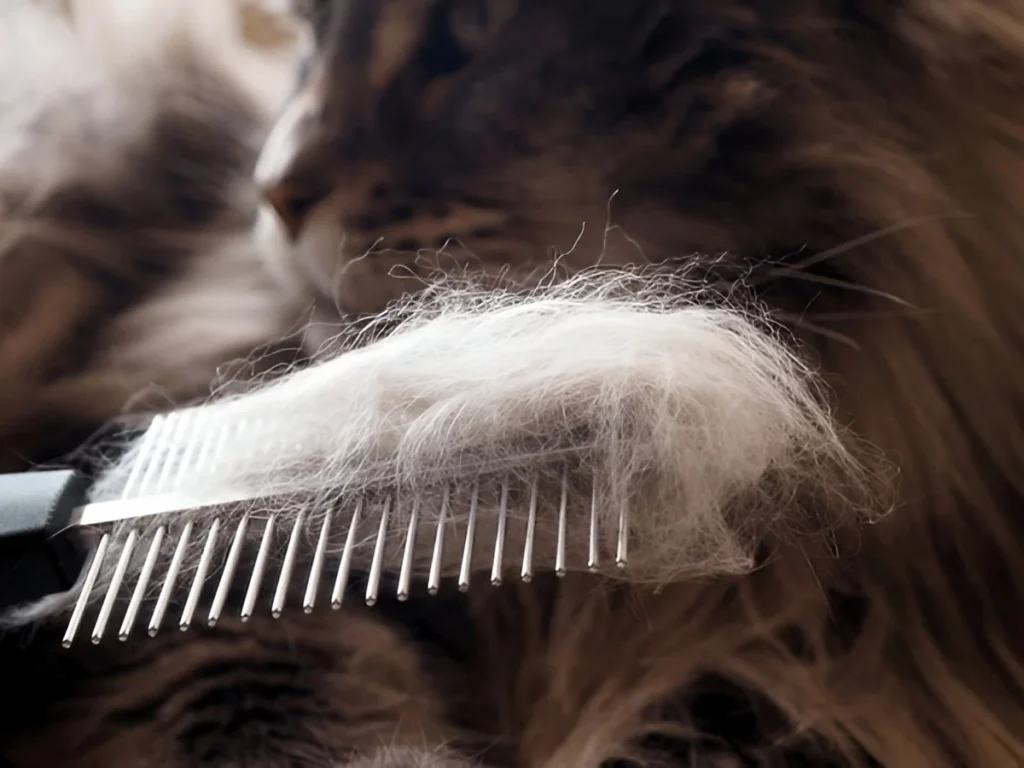
What Makes the Shedding Worse (or Better)?
Shedding has some purpose because it allows cats to eliminate old or damaged hair and allows them to adjust their coat as the seasons change. However, the frequency and amount shed are not the same for all cats.
I started to notice Max shed more when the weather warmed up, but also when he was stressed, like when we moved apartments or had visitors. I learned that factors such as temperature, stress, and even what Max eats can affect how much he sheds.
If the air in the house is dry, or if he’s not drinking enough water, he’ll shed more. And if his food isn’t high in good fats and protein, his coat gets dull and sheds more, too.
Shedding can be affected by:
- genetics (like breed type, some lines shed more than others)
- diet (feeding inferior quality foods = more shedding)
- health and stress (an unhealthy or stressed cat will shed more)
- temperature and humidity (hot weather = more shedding)
If your Maine Coon is losing clumps of fur, has bald spots, or seems itchy, it’s time to see the vet. But if you’re just seeing a steady drift of hair, it’s probably normal.
Maine Coon Vs Other Cat Breeds
When people discuss Maine Coons, shedding inevitably comes up. I’ve heard varying opinions on shedding. Some people say that Maine Coons shed more than any other cat breed, and others say that it sheds hardly at all.
I also always assumed Maine Coons would shed more than any other cats, and that isn’t the case. The fact is; Maine Coons do shed, but not more so than any other long haired cat. Shedding is a natural process in the everyday routine of sustaining a healthy coat and skin.
In fact, some breeds such as Persians shed much more than Maine Coons. Compared to short-haired cats, you might notice the fur more, but it’s not out of control.
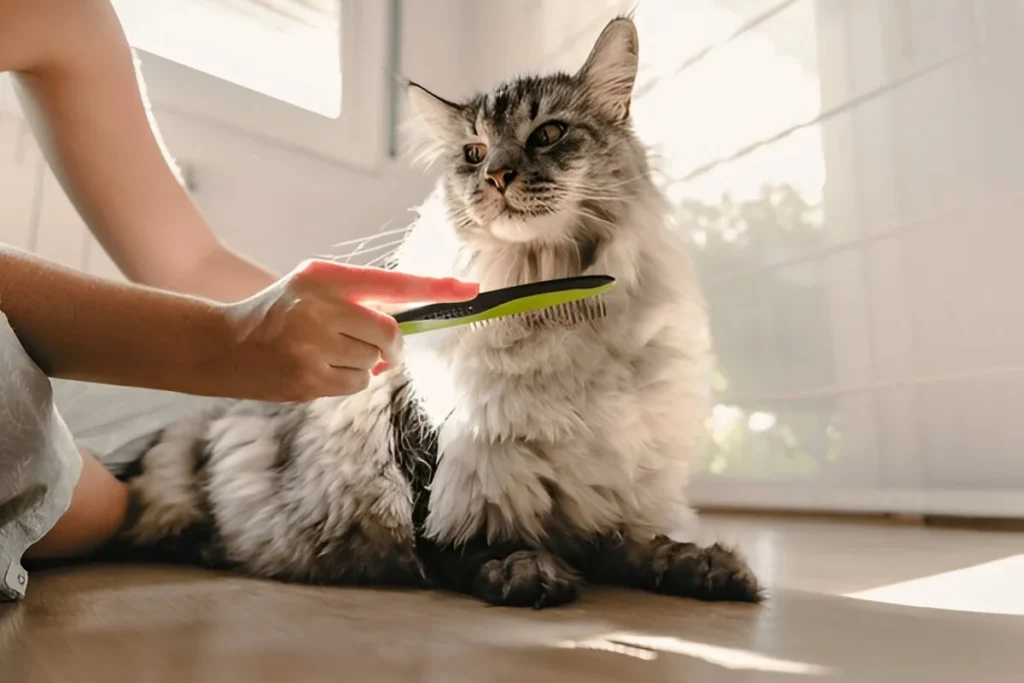
When Do Maine Coon Cats Shed the Most?
Seasonal Shedding:
Most Maine Coons shed their thick furry coat in spring and fall. In spring, they shed hair with a thicker winter coat to stay cool in the summer. In fall, they shed their thin summer coat to grow into their winter coat instead of pulling their winter coat through the entire summer.
Indoor vs. Outdoor Cats:
Indoor Maine Coons usually shed a little bit all the time because they live in a climate-controlled environment. Outdoor Maine Coons have more dramatic shedding twice a year, following the natural seasons. According to researchers, this is normal for indoor cats.
Interactive Calendar:
Try keeping a simple calendar to track your cat’s shedding. Mark down when you see more fur on the furniture or in the brush. Over time, you’ll spot a pattern and know when to step up your grooming routine.
Can Food Help Control Shedding?
The type of food your Maine Coon eats will influence how badly they will shed. Cheap cat food with many fillers will cause a dull coat and increased hair loss.
Conversely, using quality food containing protein and healthy fats, including omega-3, will help keep the skin healthy and the fur intact.
This is part of the reason Maine Coons cost so much—good breeders gave their cats high-quality food, resulting in a healthier cat and a better coat.
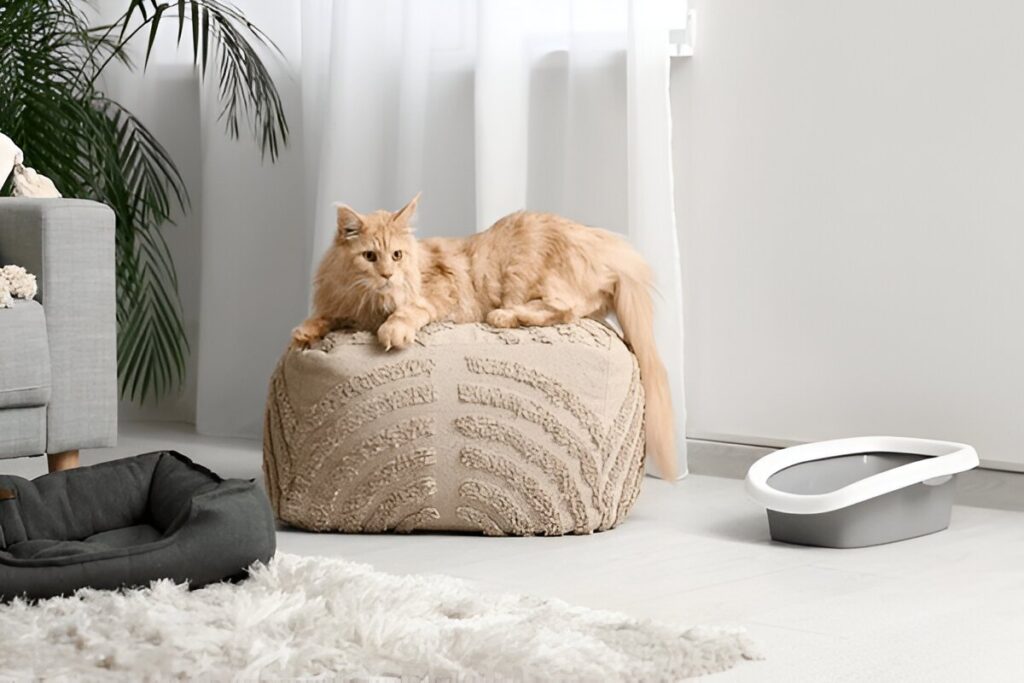
When Should You Be Concerned?
Not all shedding is considered normal. If shedding is occurring at an excessive level, is patchy, or is accompanied by other indications of concern, shedding can indicate health or environmental issues. Shedding can sometimes indicate allergies, bugs, or other health problems.
Look for indications of problems:
- Bald spots
- Red and irritated skin
- Excessive scratching or licking (especially when it makes them sore)
- Dull or patchy coat
Fur-Free Home Challenge
Are you ready to tame the fur?
Here’s a simple 7-day plan:
- Day 1: Brush your Maine Coon and save the fur in a bag.
- Day 2: Use a vacuum to clean your cat’s favorite sleeping spots and any fabric furniture.
- Day 3: Wipe down hard surfaces with a damp cloth to pick up loose hair.
- Day 4: Check your cat’s food and water bowls to see if they are clean and full.
- Day 5: Brush your cat again, paying special attention to trouble spots like the belly and legs.
- Day 6: Wash your cat’s bedding or any blankets they use.
- Day 7: Take a photo of your clean house and happy cat and share your accomplishment!
Final Thoughts
So, do Maine Coon cats shed? Yes, they do, but with the proper management, you have nothing to worry about. Most shedding is seasonal and manageable.
With consistent grooming, good nutrition, and a little patience, you and your Maine Coon can enjoy a clean and cozy home together.
Living with a Maine Coon doesn’t have to mean being overrun with fur. With some simple habits, you can stay on top of the fluff and enjoy every minute with your big, beautiful feline.
How do you deal with Maine Coon shedding? Share your tips, pictures, or comments below!
FAQs:
How much do Maine Coon cats shed compared to other breeds?
Maine Coons tend to shed more visibly than many other cat breeds due to their beautiful double-layer thick fur, which has an undercoat that is thick and dense but also has an outer cover that is water-resistant.
Is shedding different for indoor vs. outdoor Maine Coons?
Yes. Outdoor Maine Coons generally have two heavy shedding times per year, and they depend on the seasons, usually spring and autumn where they’ll “blow” their coats.
What is normal shedding vs. excessive shedding?
Normal shedding is fur that is loose on the body, usually when you are brushing the cat or cleaning it up. Excessive shedding might be a funny indication of:
- bald spots or uneven patches of thinning
- over-grooming or scratching
- visible dandruff or inflamed skin
If you experience one or more of these, you should contact a veterinarian to rule out any serious health issues.
Does coat color affect how much a Maine Coon sheds?
No. Shedding size is not determined by coat color. All Maine Coons shed approximately the same amount regardless of color.
References:
- https://pmc.ncbi.nlm.nih.gov/articles/PMC3756544/
- https://www.vet.cornell.edu/departments-centers-and-institutes/cornell-feline-health-center/health-information/feline-health-topics/hair-loss-cats
